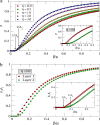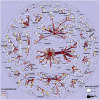The structure and dynamics of multilayer networks
- PMID: 32834429
- PMCID: PMC7332224
- DOI: 10.1016/j.physrep.2014.07.001
The structure and dynamics of multilayer networks
Abstract
In the past years, network theory has successfully characterized the interaction among the constituents of a variety of complex systems, ranging from biological to technological, and social systems. However, up until recently, attention was almost exclusively given to networks in which all components were treated on equivalent footing, while neglecting all the extra information about the temporal- or context-related properties of the interactions under study. Only in the last years, taking advantage of the enhanced resolution in real data sets, network scientists have directed their interest to the multiplex character of real-world systems, and explicitly considered the time-varying and multilayer nature of networks. We offer here a comprehensive review on both structural and dynamical organization of graphs made of diverse relationships (layers) between its constituents, and cover several relevant issues, from a full redefinition of the basic structural measures, to understanding how the multilayer nature of the network affects processes and dynamics.
Copyright © 2014 Elsevier B.V. All rights reserved.
Figures
























































References
-
- Albert R., Barabási A.-L. Statistical mechanics of complex networks. Rev. Mod. Phys. 2002;74(1):47–97. doi: 10.1103/RevModPhys.74.47. - DOI
-
- Dorogovtsev S.N., Mendes J.F. Evolution of networks. Adv. Phys. 2002;51(4):1079–1187. doi: 10.1080/00018730110112519. - DOI
-
- Newman M. The structure and function of complex networks. SIAM Rev. 2003;45(2):167–256. doi: 10.1137/S003614450342480. - DOI
-
- Watts D. Princeton University Press; Princeton, NJ, USA: 1999. Small Worlds: The Dynamics of Networks Between Order and Randomness.
Publication types
LinkOut - more resources
Full Text Sources
Other Literature Sources
Miscellaneous

